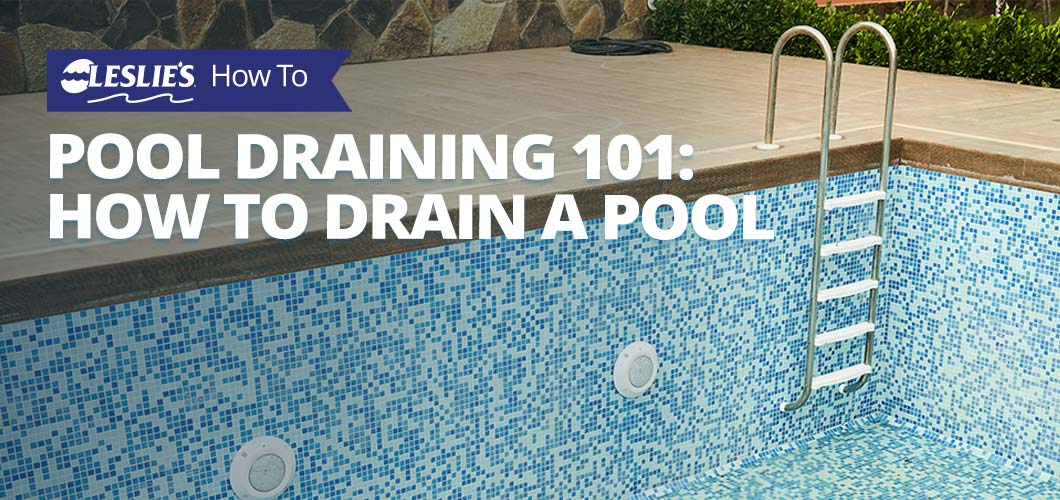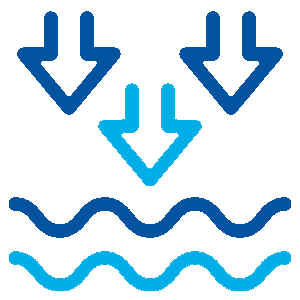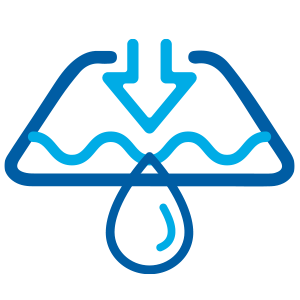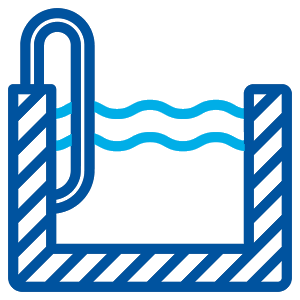
Pool Draining 101: How to Drain a Pool
There are plenty of reasons why pool owners may want to drain their pool. Some do it simply for the desire of starting pool season with fresh water or the need to repair or resurface the pool. Others may be experiencing frustrating pain points with their pool water chemistry, leading to chronic problems with algae or a constant struggle to maintain water clarity. Keeping those issues in mind, knowing exactly when to do a complete refresh of your pool water can be complex. It involves careful planning and execution to avoid potential complications.
If you find yourself questioning how to drain your pool — or how often you should drain your pool — you’re in the right place! As your trusted pool care partner, we’re here to help you know when draining your pool is the right call, as well as how to do it properly. Keep reading to learn more.
When Should I Drain My Pool?
Luckily, you don’t have to drain as frequently as you might think! While the answer to this question isn’t a universal one, the general rule of thumb is to drain your pool every three to five years. Around that three-to-five-year mark, you might begin experiencing issues with your pool that can be hard to control.
You Find Yourself Struggling With Water Balance
The first pain point you’re likely to grapple with is keeping your water balanced.

Around the three-to-five-year mark, certain pool chemistry levels may rise above the recommended range. For example, the most common reasons people drain their pools is to address high Cyanuric Acid (CYA), Calcium Hardness, or Total Dissolved Solids (TDS) levels.
Pools that use stabilized trichlor tablets or dichlor pool shock will notice their CYA levels rise over time. If you live in an area with hard water, or if you use a lot of cal-hypo pool shock, you may struggle with a high Calcium Hardness level. In addition, the TDS level rises gradually as the pool water gets balanced, treated, and used. As all three rise, it can get progressively harder to manage other aspects of water chemistry and maintain a clean, safe, and beautiful pool.
Understandably, your first instinct may be to add more chemicals to help balance the water and rid yourself of this problem. However, unlike other aspects of water chemistry, CYA, TDS, and Calcium Hardness cannot be treated that way. In most cases, the best way to manage these issues is by either diluting or fully draining your pool.
BONUS TIP: Until recently, the only way to lower a high CYA level was to dilute or drain your pool. But now, with a pouch of Cyanuric Acid Remover, it’s easier than ever to maintain the right level of CYA. Simply place it in the skimmer basket to remove CYA from the pool. It’s an easy way to save time and conserve water — talk about a win-win!
As part of your overall pool maintenance routine, we recommend testing your pool water at least once a week as a way to keep track of your water balance over time.
You’re Noticing Changes in Your Pool’s Appearance

We all love a sparkling pool, so when the water goes from crystal clear to dull and cloudy with the continuous appearance of algae, it’s a dead giveaway that something is up with your water balance. As mentioned earlier, high CYA, TDS, and Calcium Hardness levels are all reasons to drain the pool, and they can all have a negative impact on your pool’s appearance.
For starters, let’s talk about Calcium Hardness. The harder your water, the harder it is to keep calcium scale from forming on pool surfaces — especially along the waterline and inside your pool equipment. Not only does this make the pool look bad, but it can actually lower the efficiency of your pool systems, including the pump, filter, heater, salt cell, and more. When your Calcium Hardness level approaches 800 parts per million (ppm) or higher, not even stain and scale prevention products can help. Not only will you need to drain the pool to keep the level in check, but you may also need to drain it to get rid of excessive scale buildup.
BONUS TIP: If your primary water source already has a high Calcium Hardness level, refilling with fresh water may not help much. In these cases, look into a water hauling service to deliver fresh, pre-treated water for your pool. This can often provide softer water than what’s available from the spigot.
Next up, Cyanuric Acid. Also known as stabilizer, conditioner, or good ol’ CYA, a high level can impact your chlorine’s ability to work efficiently. This can lead to issues with cloudy, unsanitary, algae-filled water as it loses its ability to break down organic contaminants. In addition, high Total Dissolved Solids can also contribute to cloudy water issues, because your pool is oversaturated with minerals, salts, metals, and other suspended organic and inorganic materials.
You Need to Complete Pool Resurfacing, Repair, or Maintenance Projects
At some point, many pool owners will need to empty the pool to do certain types of repair work on interior pool surfaces. This can include acid washing to remove stains and scale. Repairs and maintenance may also involve resurfacing, repainting, or fixing cracks in the walls. If you have a vinyl liner in need of replacement, this, too, calls for a complete pool draining.
Important Tips Before You Start Draining Your Pool

- Check with your local municipality to find out when and where you can drain your pool water. For example, most areas have ordinances against discharging water into storm drains.
- Consider the groundwater levels in your area. High groundwater levels can cause an empty inground pool to float, which can literally pop the pool out of the ground. If you’ve had recent rains or have high groundwater levels, it’s best to talk to a pool pro first or only partially drain your pool.
- Never completely drain a fiberglass or inground vinyl-lined pool. Doing so can damage the integrity of the pool surface or liner, resulting in bowing or cracking. The only time you should fully drain a vinyl pool is if you’re replacing the liner. Otherwise, the best practice is to partially drain and refill these types of pools by a foot of water at a time.
- To avoid damaging your pool pump or lights, remember to always turn off the breaker to your equipment before draining water from the pool. Also remove the timer trippers.
- Never use your pool pump to try to drain the pool. Inevitably, you will pull air into your suction line, the pump will lose its prime, and you will damage or burn up your pump. Always use a submersible pump to drain the pool.
How to Drain Your Pool

There are different ways to refresh your pool water, and it doesn’t always involve fully draining the pool. If you are experiencing minor issues with chemistry imbalances, pool owners can simply dilute the existing water. Start with draining a foot of water and then adding a foot of water at a time.
To remove water from the pool, you’ll need a submersible pump. Just as it sounds, a submersible pump is used completely underwater. Connect your submersible pump to a garden hose and then lower it into your pool. Once you turn the submersible pump on, the draining process will begin. If you’re only partially draining and refilling the pool, keep a close eye on the water level. Stop the submersible pump once the water lowers by a foot. Refill the water to normal operating levels, then retest the pool to see if you need to dilute the water further. Repeat as needed until your high CYA, TDS, or Calcium Hardness are back within ideal ranges.
If your pool is due for a full draining, we strongly recommend consulting a pool professional. Unfortunately, a lot of things can go wrong if a pool isn’t drained properly. In most cases, it’s best to have a licensed, bonded, and insured professional do the job for you.
BONUS TIP: Did you know that Leslie’s offers professional pool draining services? It’s true! If your water needs a refresh, or if you have a resurfacing or repair project in your future, you can count on the experts at Leslie’s to help you get the job done right. Stop by your local Leslie’s or fill out the appointment request form online to see if we provide services in your area. Our certified team of experts can also provide acid washing and tile cleaning services while the pool is empty.
Side Effects of an Improperly Drained Pool
Without sufficient research, preparation, and know-how, improperly draining your pool can lead to a number of issues, including structural and surface damage, flooding, damage to your home’s foundation, and more. This is why we highly suggest working with a licensed pool contractor who is familiar with local drainage laws and understands the best practices for safely draining a pool.

Even if you only plan to drain part of the water, be mindful of the time of year in which you drain your pool. Pool liners, fiberglass, and other sensitive pool surfaces are not designed to withstand sunlight without water. The same applies to plaster pools. Both intense heat and the sun’s rays can severely damage pool surfaces, leading to costly repairs.
When possible, drain the pool when the outside air temperature is less than 85°F. Spring and fall are generally the best times to completely drain your pool. In the peak of summer, early morning and evening hours are the best times to dilute existing water or partially drain a pool.
BONUS TIP: Be mindful of how long you leave your pool empty. In-ground pools are designed to always have water weighing them down and protecting the pool surfaces. When the pool is empty, especially for a prolonged time, it’s easy for it to shift or crack, causing costly structural damages.
Are You Ready to Drain Your Pool?
As you now know, draining your pool doesn’t need to be part of your seasonal maintenance routine — only as needed to control certain aspects of water chemistry or to repair or resurface the pool. The best way to maintain a healthy pool and reduce the need for draining is to test your water weekly. Regular testing is the best indicator of the direction your water is heading. For the most accurate water analysis, just bring a water sample to your local Leslie’s for a FREE in-store AccuBlue® water analysis and a customized, 10-point water treatment plan. If the results indicate that draining is necessary, we can provide additional guidance for a DIY approach, or we can schedule one of our certified professionals to come out and safely drain the pool for you.
No matter what you need for your pool, you can count on Leslie’s to have the products and expertise to help you get the job done right the first time. For more information on pool care and equipment maintenance, check out our Resource Center, visit our YouTube channel, or stop by your local Leslie’s and speak with one of our experts!